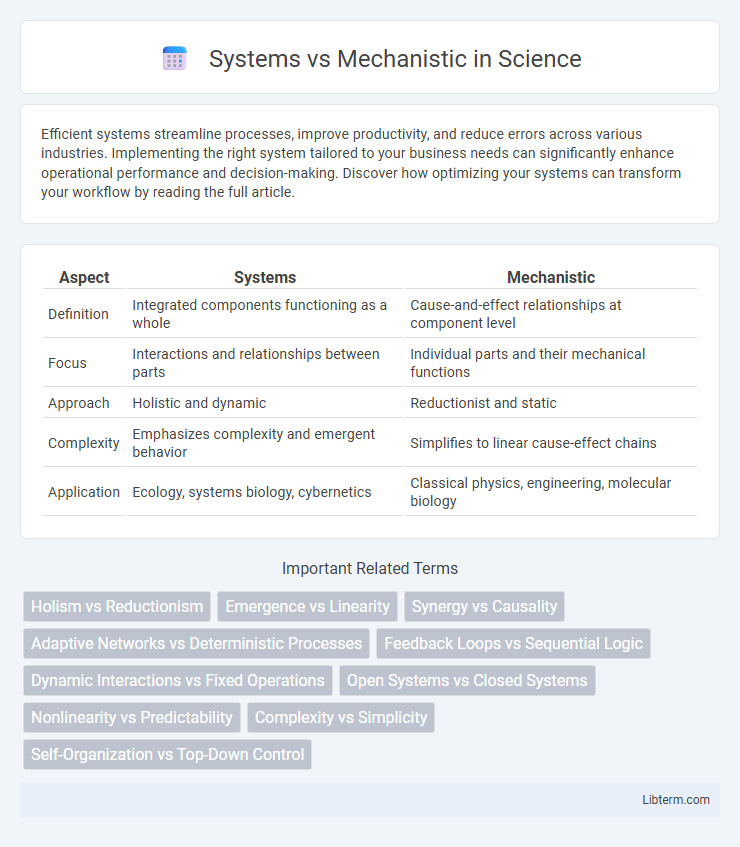Efficient systems streamline processes, improve productivity, and reduce errors across various industries. Implementing the right system tailored to your business needs can significantly enhance operational performance and decision-making. Discover how optimizing your systems can transform your workflow by reading the full article.
Table of Comparison
| Aspect | Systems | Mechanistic |
|---|---|---|
| Definition | Integrated components functioning as a whole | Cause-and-effect relationships at component level |
| Focus | Interactions and relationships between parts | Individual parts and their mechanical functions |
| Approach | Holistic and dynamic | Reductionist and static |
| Complexity | Emphasizes complexity and emergent behavior | Simplifies to linear cause-effect chains |
| Application | Ecology, systems biology, cybernetics | Classical physics, engineering, molecular biology |
Understanding Systems Thinking
Systems thinking emphasizes holistic analysis by examining interactions and interdependencies within a system, contrasting with the mechanistic approach that views components in isolation. This perspective enables deeper comprehension of complex processes and emergent behaviors that arise from system dynamics. Understanding systems thinking enhances problem-solving by considering feedback loops, adaptability, and the overall structure influencing outcomes.
What Defines a Mechanistic Approach?
A mechanistic approach is defined by its focus on structure, hierarchy, and standardized procedures to achieve efficiency and predictability within organizations. It emphasizes rigid departmentalization, centralized decision-making, and clear chains of command to control processes and outcomes. This approach suits stable environments where tasks are routine and precision is critical for operational success.
Key Differences: Systems vs Mechanistic
Systems approaches emphasize the interrelations and dynamic interactions between components within a whole, fostering adaptability and complexity in organizational structures. Mechanistic approaches focus on rigid hierarchies, clear roles, and predictable processes designed for efficiency and control in stable environments. Key differences lie in flexibility and complexity, with systems favoring holistic, adaptive frameworks, while mechanistic models rely on fixed, prescriptive procedures.
Origins and Historical Context
Systems theory originated in the early 20th century, influenced by biologists like Ludwig von Bertalanffy, who emphasized the interdependence of components within a whole. Mechanistic approaches trace back to the Enlightenment era, rooted in the work of Rene Descartes and Isaac Newton, focusing on the world as a complex machine governed by cause-and-effect relationships. The historical context of systems theory emerged as a response to the limitations of mechanistic models in explaining biological and social complexity.
Components and Interactions in Both Models
Systems models emphasize dynamic interactions and feedback loops among components, highlighting their interdependence and collective behavior. Mechanistic models focus on discrete components and their linear cause-effect relationships, detailing specific parts and functions without extensive consideration of system-wide interactions. Both approaches analyze components, but systems models prioritize emergent properties from interactions, while mechanistic models dissect individual elements for precise functional understanding.
Flexibility vs Rigidity: Adaptation in Each Model
Systems models emphasize flexibility by allowing dynamic interactions and continuous adaptation to environmental changes, fostering innovation and responsiveness. Mechanistic models exhibit rigidity through fixed hierarchies and standardized procedures, limiting their ability to adjust quickly to new challenges. Adaptation in systems models is driven by feedback loops and collaborative processes, whereas mechanistic models rely on strict control and predictable outcomes.
Real-World Applications: Systems vs Mechanistic
Systems thinking enables organizations to address complex problems by analyzing interrelated components and feedback loops, crucial in healthcare management and environmental sustainability projects. Mechanistic approaches apply well in manufacturing and assembly line optimization, where tasks are standardized and predictable processes dominate. Real-world applications demonstrate systems models excel in dynamic, adaptive environments, while mechanistic models suit stable, repetitive operations.
Strengths and Limitations of Each Approach
Systems approach excels in handling complex, dynamic interactions within organizations, promoting holistic understanding and adaptability; however, it can be challenging to implement due to its complexity and the need for continuous feedback and adjustment. Mechanistic approach offers clear structure, defined roles, and efficiency in stable environments, making it easier to manage and control operations, yet it tends to be rigid and resistant to change, limiting innovation and responsiveness. Balancing these strengths and limitations is crucial for organizations aiming to optimize performance and responsiveness in varying contexts.
Choosing the Right Model for Your Organization
Choosing the right organizational model between systems and mechanistic approaches depends on the complexity and adaptability needs of your business. Systems models emphasize interrelated components and dynamic interactions, ideal for organizations facing rapid change and requiring flexibility. Mechanistic models suit stable environments with clear hierarchies, promoting efficiency through standardized tasks and rigid structures.
Future Trends: Integrating Systems and Mechanistic Thinking
Future trends in integrating systems and mechanistic thinking emphasize hybrid models that leverage the strengths of both approaches for enhanced problem-solving in complex environments. Advances in artificial intelligence and machine learning enable dynamic systems analysis combined with mechanistic insights, promoting predictive accuracy and adaptive solutions. This integration drives innovation in fields like healthcare, engineering, and environmental science, fostering resilient and scalable strategies.
Systems Infographic

 libterm.com
libterm.com